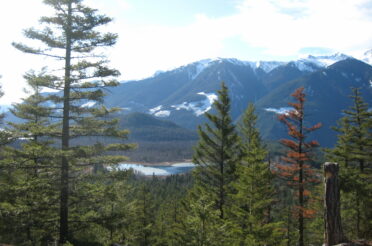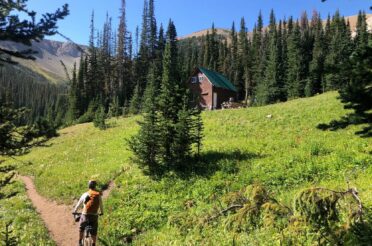Conservation starts with education

I have always had an interest in conservation. In my previous job as an out of school care educator; I used to facilitate events with the kids, where we would pick out invasive species, pick up litter while learning about our immediate environment.
I also went to 2 lectures led by Jane Goodall and listened to Cristina Mittermeier talk about Sea Legacy and her work for National Geographic. Yet I still had a hard time applying the concept of conservation to me.
When I came to the ranch, I learned about the area surrounding us, about the South Chilcotin Mountains and all the life within its grounds. I learned about the history, from the fossils of the Eocene era, 50 millions year old rocks looking over young lives of bustling insects to mammals within lush vegetation and trees. The same land roamed by first nations (NAME OF TRIBES) for generations where they would hunt goats, marmots and harvest plants for food and medicinal purposes. The story of the land continues on to the settlers using it for grazing for their animals, with some 4,300 sheep coming to feed on the lush grass of the alpine meadows, and of course I learned about the mining history, in front of the old mine shaft all collapsed now, but if you listen closely, you can imagine and hear echoes of the past, when the mine was bustling and gold was extracted from the Earth.
I
learned about the symbiotic relationship between the land, the plants
and the animals. About the nutcracker that stashes pine-cones from
the white bark pine tree, then forgets about it. The secret stashes
then becoming clusters of new trees…. The white bark pine tree, as
it turned out, is very special to this land. When Carpenter lake was
built in the 1950s, the salmon run was cut off, removing the main
source of food for the local population of grizzly bears. But the
anchor of survival is adaptability and the remaining bears did so by
eating the pine cones of the special tree. These pine cones are so
nutritious that the bear population is thriving again. It is not a
rare sight around here, to see a mama bear with 3 to 4 cubs.
The
more time I spend here, especially in the mountains, the more I
understand this symbiotic relationship. Nature doesn’t question its
place or right to be in a certain place. Nature just is. The fungus
grows on the tree, the fallen tree serves as a nursery for the next
generation. The bears dig up the beautiful meadows for larvae,
insects and wild potatoes so it can survive the winter, tucked away
in its den under the tree.
Going on horseback in the wilderness is such a privilege. First because this is where the horses live. They know the land, where to step and what lies within the shadow of a thick bush. You get to go slow. You get to listen to the wind through the trees and feel it change direction as you go. You get to see the rising sun and the pink clouds, omen of a cold, rainy day. You get to see more stars than you can dream of, shining high up with the milky way, if you stay awake long enough. You hear the sound of distant animals grazing, howling, going about their lives in their fight for survival.
I
used to be scared in the woods. Concerned that every animal out there
was lurking around, ready to attack me. But I have learned now, that
we are lucky to be tolerated within their home, the Alpine Meadows.
That we are not that important to them, more of a disruption really.
And it is our duty to enter their home respectfully. You never hear
if you don’t listen. You never see if you’re not looking.
Our
smell and horses’ heavy steps can be heard throughout the area by the
keen ears of the local wildlife. It’s easy to feel like you are
alone, surrounded by wild flowers and the occasional raven or
nutcracker. But if you learn to look you see the deer track followed
by the lone wolf. You see the shedded wool of the mountain goats on a
warm day on top of the ridge. You see the old moose scat and the
scarred tree, where the bear marked his territory.
I was extremely lucky, just about every time I went up to our camp Eldorado, to be able to see the elusive and shy mountain goats. BC holds 52% of the world’s population. The main issue with conservation around the globe is habitat loss. And we hold, within our mountains, a perfect environment for them.
We
got to observe sure footed tracks on the ridge ride, picked up
shredded wool and observed a group as big as 26 nannies with babies,
grazing on what seems to the untrained eye, like a barren, desolated
land of rocks and steep slopes. The goats graze on shrubs and lichen,
the mothers will protect their young from grizzlies, wolves, eagles
and even from falls, by standing below them on the steep hill. I
always feel so very lucky when, from a safe distance, I can observe
them with my binoculars, grazing away, undisturbed.
On my last
trip 2 mountain bikers came barrelling down the ridge, spooking the
goats who galloped away towards the other versant of the mountain,
steeper, hidden away. They were lovely people and stepped aside as we
rode passed. They asked us if we saw “the sheep”.
And that’s when I finally understood how I, myself, could make a difference in my immediate environment. Conservation starts by education. If people don’t know, they will not care. It is neither good nor bad, it is just a fact of life. Whenever you meet someone, for a split second or an hour that turns into days or months, you make an impact. And you have the power to decide what that impact will be.
My role here, I am finding out, is to know the land I am guiding in. Not just the trails and the way home – although it does come in handy!- but the history, its inhabitants and what to do to protect them.
“They are actually mountain goats, remnants of the ice age!” I said with a smile. “They are very special. Slow down and look for the scat, wool and footprints”.
I do not know that they did, but our exchange was positive, and I hope they at least learned to differentiate wild sheep from goats from now on.
You are never too small or too busy to make an impact. Where you are is who you are. Even the city holds a past of lush forests or vast meadows. Make sure you take a second from your commute, busy schedule or day and look up! Listen to the stories of the land you live in.
Conservation is everywhere, all around and within everyone’s reach!
Moon



